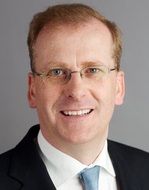Frank Talsma, Director, Risk & Investment Analytics at RBC Investor & Services; Claire O’Brien, Director, Client Coverage at RBC Investor & Treasury Services: UCITS funds continue to thrive on high demand driven by brand recognition, a reputation for investor protection and sound risk management principles (e.g. enhanced liquidity risk management) and most importantly the growth potential through cross-border distribution.

Frank Talsma
Alternative funds (AIFMD) are also benefiting from this legacy. ESG and thematic funds are on the rise and we are witnessing funds repurpose themselves. SFDR is a driver here for fund ESG classification.
ETFs, real assets and other alternatives continue to grow and we do not believe they are a threat to UCITS and all asset classes can easily co-exist. In Ireland the majority of ETFs have been set up under the UCITS regime which would point to the investor confidence in the UCITS framework. Low cost passive funds have been on the rise for years but active management deep stock analysis and stock picking continues to add value and deliver performance.
The updated ILP framework now provides fund sponsors with access to a range of attractive features that match other private fund domiciles. The new and improved ILP fund structure includes a flexible limited partnership vehicle with an additional layer of Central Bank of Ireland (CBI) regulation that provides an enhanced level of comfort and value for investors.
The variety of product in the market makes for a competitive environment and one which can meet the needs from the most sophisticated investor to retail.
The regulatory environment continues to remain a focus and will continue to shape products, the rise in ESG funds in response to ESG rules such as SFDR, Taxonomy and CSDR is the latest trend to be embedded in all asset types.
David Dillon, Director (Ireland), MJ Hudson:

David Dillon
We have seen a dramatic growth in ETFs recently. This was often spoken about in the context of passive versus active investment and a move away from active investment due to a perceived lack of a cost benefit contribution and the failure of active Managers generally to deliver better than market performance.
Anecdotally, I think certain Managers are now distinguishing themselves from the market and also different management styles are delivering different results not judged solely on absolute performance but also risk adjusted performance. I wonder if ETFs will be just one tool in the investment armoury of investors?
We at MJ Hudson have noticed a significant number of equity strategies being established which suggests that the circumspection around active management might be coming to an end.

Meliosa O'Caoimh
: The last two years has proven a timely reminder of the old adage that the future is extremely hard to predict! Northern Trust recently completed developments in its ETF business to help clients exploit the accelerating growth being seen in ETFs, and we have been pleased with client adoption to date. UCITS remains the biggest component of our business and we have seen significant interest in various alternative structures.
Our business planning continues to draw on intelligence from our clients, and feedback on their plans and ambitions. Our solutions evolve in conjunction with our clients’ requirements: we plan to be in the market wherever they need us to support their funds – and where their investors need them.
Donncha Morrissey, Head of Branch, Sparkasse Bank Malta plc Ireland Branch: With European AUM at end Q2 2021 across UCITS and AIFs of approx €20tn and ETFs accounting for approx. €1.2tn of that figure, the overall UCITS product of €12tn continues to dominate the European fund landscape.

Donncha Morrissey
Investment diversification will be sought via alternative products as these products mature there will be increasing demand for them. The maturity point is key, the UCITS product is now 36 years old and the numbers outlined demonstrate its success, the first ETF in Europe is just over 20 years old, and the real asset space as a product is developing through the construct of the Irish Limited Partnership and recent introduction of specialist service providers to the market servicing that asset class. As we know UCITS is now in its fifth iteration and we can expect each of these alternative products will continue to grow, adapt and offer alternative cost models, returns and diversification of exposure to investors re their portfolio.
Confidence in each of these products develops over time, some won’t want to be an early adopter and continue to reside in the comfort zone, this is natural and why the mature product will continue to succeed at the same time capital is deployed into the alternative asset classes and products.

Conor Joyce
: In recent years there has been growing interest in ETF funds amongst retail investors. Some of the key driving forces behind this demand include lower costs, better transparency and the superior liquidity of these passive-type strategies when compared to the traditional mutual fund UCITS. This increased investor demand has fed the trend of asset managers converting traditional mutual fund UCITS into passive ETFs.
Another emerging trend that may harm the demand for ‘plain vanilla’ UCITS funds is the increased demand for real asset-type strategies. These will potentially become more accessible to the average retail investor through tokenization and distributed ledger technology, and in many cases, also offer higher returns.
Traditional UCITS funds remain popular with many retail investors, however. They will likely remain the fund of choice for those who like actively managed products - the more successful of which can offer excellent returns and the highly regulated and safe nature of UCITS funds in comparison to some alternative strategies.
Going forward, a key factor impacting the future popularity (or not) of traditional UCITS funds will be the fees associated with active management which remain significant. Figures published by ESMA in April 2021 highlighted that the pace of fee reduction for mutual fund UCITS has been slow. For example, fees on one-year investments stood at 1.5% in 2018, only dropping to 1.4% in 2019 on average across asset classes.
If fees remain higher than passive funds it seems safe to assume investor demand - followed by asset managers - will continue to move to more passive strategies.
Tadhg Young, Executive Vice President, Country Head – Ireland, State Street: In the US, we are seeing asset managers take advantage of the new “ETF Rule” approved by the SEC in 2019 which lowers the barriers of entry for them to launch ETFs in the US. There is also a capital gains tax exemption for ETFs and the underlying basket in-kind in the US which is an incentive for ETF investment. We have, therefore, seen a number of asset managers converting their mutual funds into ETFs in the US.
However, as there are no similar tax or relief benefits to asset managers launching ETFs in Europe, we do not expect to see the same level of conversions from mutual funds to ETFs in this region. The majority of investment in European ETFs is still through institutional investors which is the opposite of what is seen in the US with retail investors representing over 60% of the investor pool.

Tadhg Young
There will always be a strong appetite in Europe for traditional mutual funds for retail investors based on track record.
It is true, however, that the level of ETF growth in Europe continues to increase on an annual basis with investment in ETFs in the whole of 2020 ($120bn) being surpassed by August of 2021 ($136bn). As investors continue to move their money from more expensive traditional mutual funds to cheaper ETFs offering similar exposures, we are seeing the growth of the overall ETF market with a 10 year CAGR of 15.2%. ETFs are being used as building blocks for model portfolios, and are also being included in hedge portfolios and other investment products to gain exposure to a wide range of assets with one trade.
Due to continued education of the retail investor market on ETFs and an increase in retail managing their own money, we will continue to see the shift to ETFs increase as time goes on.





